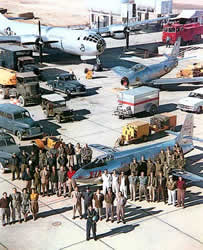 The time was December of 1953. It was a time when, as Scott Crossfield later recalled, Edwards AFB could be compared to “an Indianapolis of the air”. Indeed, it was even more than that, he concluded, because it was “an Indianapolis without rules” where he and his peers “lived with the feeling that everything we were doing was something that probably had never been attempted or even thought of before”. It was an age when the limits of time, space, and the imagination were being dramatically expanded and, while now recalled as a kind of “Golden Age” by many of those who lived through it, it was also a time when the hazards encountered in flight testing were far more commonplace than they are today.
The time was December of 1953. It was a time when, as Scott Crossfield later recalled, Edwards AFB could be compared to “an Indianapolis of the air”. Indeed, it was even more than that, he concluded, because it was “an Indianapolis without rules” where he and his peers “lived with the feeling that everything we were doing was something that probably had never been attempted or even thought of before”. It was an age when the limits of time, space, and the imagination were being dramatically expanded and, while now recalled as a kind of “Golden Age” by many of those who lived through it, it was also a time when the hazards encountered in flight testing were far more commonplace than they are today.
Flying for the National Advisory Committee for Aeronautics (NACA), a civilian test pilot had just scored a major triumph. In a masterful performance on 20 November, he had piloted the sweptwing Douglas D-558-II Skyrocket to a speed of 1,291 mph in a shallow dive at 62,000 feet and thereby became the first man to fly at twice the speed of sound – but just barely, at Mach 2.005. It was a remarkable achievement, all the more so because the Skyrocket had not originally been designed to fly much beyond Mach 1.5. The D-558-II was a U.S. Navy airplane, and following a civilian test pilot’s flight, it appeared that the Navy and the NACA were going to enjoy “bragging rights” when the 50th anniversary of powered flight was celebrated on 17 December.
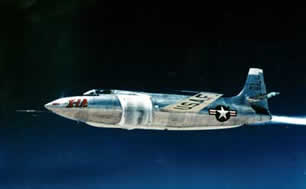
There was another rocket-powered airplane just entering test down the flight line at Edwards, however, which had been designed to fly well beyond Mach 2. That airplane was the Air Force’s Bell X-1A, a “stretched” second-generation version of the X-1 which incorporated a low-pressure turbopump fuel system, increased fuel capacity which would permit 4.65 minutes of full four-chamber burn time for its 6,000 pound thrust XLR-11 engine, as well as a host of other improvements.
Bell’s design engineers predicted that the X-1A would be able to achieve 2 1/2 times the speed of sound.
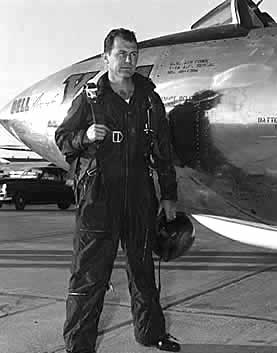 A test pilot observed that “Edwards was not the place to attract non-competitive pilots” and then-Lt Col Pete Everest, who was chief of flight test operations, later recalled that if “the Skyrocket [had] been purely a Douglas project, perhaps we would not have felt so competitive about it, but as it was sponsored and built for the Navy, naturally some feelings of inter-service rivalry was bound to exist”. The sense of rivalry was not just between the military services.
A test pilot observed that “Edwards was not the place to attract non-competitive pilots” and then-Lt Col Pete Everest, who was chief of flight test operations, later recalled that if “the Skyrocket [had] been purely a Douglas project, perhaps we would not have felt so competitive about it, but as it was sponsored and built for the Navy, naturally some feelings of inter-service rivalry was bound to exist”. The sense of rivalry was not just between the military services.
At Edwards, in fact, it was every bit as spirited – and far more immediate – between many of the Air Force and NACA pilots. Everest assigned Maj. Chuck Yeager to take over the X-1A envelope expansion program and Yeager and his long-time sidekick and flight test engineer, Maj. Jack Ridley, devised a flight program they dubbed “Operation NACA Weep” to steal the NACA and Navy’s thunder before the 17 December anniversary.
Yeager completed his first powered flight – a familiarization flight to Mach 1.15 – the day after a civilian test pilot’s record flight, on 21 November. On his next flight to Mach 1.5, on 2 December, he reported excessively heavy stick forces. Then, on December 8 he flew the X-1A to a speed of Mach 1.9 in a slight climb at 60,000 feet.
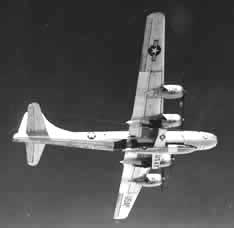 Apart from the heavy stick forces, everything had gone smoothly to this point. Following this third flight, however, Bell engineers warned him to fly with extreme caution because the airplane might well “go divergent” at speeds above Mach 2.3. Nevertheless, in the spirit of that now-bygone age, they pushed ahead to an “optimum climb path” max-performance profile just four days later, on 12 December. What occurred that day is well known – recreated in purple prose by pulp writers and on celluloid by Hollywood. Those efforts, however, are really not as compelling – or as interesting and, perhaps, even instructive – as the words of the participants.
Apart from the heavy stick forces, everything had gone smoothly to this point. Following this third flight, however, Bell engineers warned him to fly with extreme caution because the airplane might well “go divergent” at speeds above Mach 2.3. Nevertheless, in the spirit of that now-bygone age, they pushed ahead to an “optimum climb path” max-performance profile just four days later, on 12 December. What occurred that day is well known – recreated in purple prose by pulp writers and on celluloid by Hollywood. Those efforts, however, are really not as compelling – or as interesting and, perhaps, even instructive – as the words of the participants.
What follows is the record as preserved in the pilot’s report and the official transcript of the radio communications that day. Jack Ridley was flying low chase and Maj. Arthur “Kit†Murray high chase, both in F-86s, and Maj. Harold Russell was the B-29 launch pilot.
DeYoreo: Roger, we’re all clear to drop at any time.
B-29 Pilot: Okay, I’m building up speed, 32,000 feet now, 210 miles an hour. Charlie, when I kick you out, you will probably be about approximately 10 miles north of Victorville on a heading of 280 [degrees].
Yeager: Okay. Boy, make sure it’s a minute when you drop me. It’s about 30 seconds from now, I recon.
B-29 Pilot: Okay. You give me the word for the countdown.
Yeager: Okay, start your countdown slowly.
B-29 Pilot: Okay, starting countdown starting from 5 down to zero. 5 – 4 – 3 – 2 – 1 Okay, drop her Danny.
Co-Pilot: Drop.
Yeager: Firing 4.
Chase (Ridley): No light, just fuel.
Yeager: Is it on now?
Chase (Ridley): Yes.
Yeager: Fired #2.
Bell Truck: What cylinders are on, Chuck?
Yeager: #3 coming on now. Start.
Yeager: Cylinder seconds on 250 right now.
Yeager: Cylinder seconds back to 97 right now.
Bell Truck: We have your time, Chuck.
Yeager: Okay.
Yeager: Push over.
Bell Truck: 20 seconds.
Chase (Ridley): Got him in sight, Kit?
Chase (Murray): No, he’s going out of sight – too small.
In his pilot’s report, Yeager matter-of-factly described the sequence of events following launch:
“After a normal drop at 31,000 feet, chambers #4, #2, and #1 were ignited and [the] airplane was accelerated up to .8 Mach number. A flight path was formed holding .8 Mach number up to 43,000 feet where chamber #3 was ignited and the airplane accelerated in level flight to 1.1 Mach number. A climb was again started passing through 50,000 feet at 1.1 Mach number, 60,000 feet at 1.2 Mach number and a push-over was started at 62,000 feet. The top of the round-out occurred at 76,000 feet and 1.9 Mach number.
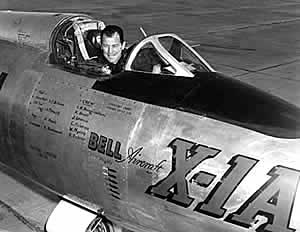 The airplane was accelerated in level flight up to 2.4 [2.535 indicated] Mach number where all of the rocket chambers were cut. The flight path was very normal and nothing uneventful [sic] happened up to this point.
The airplane was accelerated in level flight up to 2.4 [2.535 indicated] Mach number where all of the rocket chambers were cut. The flight path was very normal and nothing uneventful [sic] happened up to this point.
After the engine was cut, the airplane went into a Dutch roll for approximately 2 oscillations and then started rolling to the right at a very rapid rate of roll. Full aileron and opposite rudder were applied with no effect on the rate of roll of the airplane.
After approximately 8 to 10 complete rolls, the airplane stopped rolling in the inverted position and after approximately one-half of one second started rolling to the left at a rate in excess of 360 degrees per second, estimated by the pilot. At this point the pilot was completely disoriented and was not sure what maneuvers the airplane went through following the high rates of roll.
Several very high “g” loads both positive and negative and side loads were felt by the pilot. At one point during a negative “g” load, the pilot felt the inner liner of the canopy break as the top of his pressure helmet came in contact with it.
The first maneuver recognized by the pilot was an inverted spin at approximately 33,000 feet. The airplane then fell off into the normal spin from which the pilot recovered at 25,000 feet.”
At this point in time, nobody— except for Yeager— had any idea of what he had just been through. Ridley and Murray had repeatedly attempted to communicate with him but, for obvious reasons, to no avail (and the development of reliable telemetry to the ground and radar tracking systems still had a ways to go in the early 50s). As Yeager recovered the aircraft, he was able to re-establish radio contact for the first time since he had commenced his push-over at 62,000 feet more than two minutes earlier:
Yeager: (Illegible – inaudible – gasping) – I’m down to 25,000 over Tehachapi. Don’t know whether I can get back to the base or not.
Chase (Ridley): At 25,000 feet, Chuck?
Yeager: Can’t say much more, I got to (blurry) – save myself.
Yeager: I’m – (illegible) – (Christ!)
Chase (Ridley): What say, Chuck?
Yeager: I say I don’t know if I tore anything up or not but Christ!
Chase (Murray): Tell us where you are if you can.
Yeager: I think I can get back to the base okay, Jack. Boy. I’m not going to do that anymore.
Chase (Murray): Try to tell us where you are, Chuck.
Yeager: I’m (gasping) – I’ll tell you in a minute. I got 1800 lbs [nitrogen] source pressure.
Chase (Murray): Chuck from Murray, if you can give me altitude and heading, I’ll try to check you from outside.
Yeager: Be down at 18,000 feet. I’m about – I’ll be over the base at about 15,000 feet in a minute.
Chase (Murray): Yes, sir.
Yeager: Those guys were so right!
Yeager: Source pressure is still 15 seconds, I’m getting OK now.
Yeager: I got all the oscillograph data switches off. 4 fps camera off, it’s okay.
Bell Truck: Jettison and vent your tanks.
Yeager: I have already jettisoned. Now I’m venting both lox and fuel. Leaving hydrogen peroxide alone.
Bell Truck: Roger.
Yeager: I cut it, I got – in real bad trouble up there.
Yeager: Over the base right now, Kit, at 14,500 feet.
Chase (Murray): I have you.
Yeager: Does everything look okay on the airplane?
Chase (Murray): I’m still catching up to you.
Yeager: Going to do a 360 here to the left.
Chase (Murray): I don’t have you, that’s a T-33.
Yeager: I’m right over the end of the diagonal runway – right over the North-South runway at the 3 1/2 mile marker. I’m going to make a right-hand pattern.
Yeager: Gear coming down. Source pressure is still 1650. Gear down and locked.
Yeager: Kit, got me in sight yet?
Yeager: Huh?
Chase (Murray): Negative.
Yeager: Came down to 12,000 feet on a right-hand downwind leg over the end of the East-West runway in the sound end of the lake.
Chase (Murray): All right, roger, I see him.
Chase (Ridley): Got him, Kit?
Chase (Murray): Yes.
Yeager: Flaps coming down.
Yeager: Source pressure still 1600.
Yeager: I’m a little bit fogged up – not too bad.
Chase (Murray): No, I don’t have you, Chuck.
Yeager: I’m on the base leg, I’ll be landing on 35 right in a minute.
Maj. Thompson (on ground): Kit, swing to the right sharp, clear down on the edge of the lake bed, this is Tommy.
Yeager: I’ll be down over the South track there in a minute, down to 7,000 feet.
Chase (Murray): Roger.
Yeager: Going to land a little long, I would appreciate [it] if you’d get there and get this thing off (meaning pressure suit.) I’m hurting.
Maj. Thompson: On the final, Kit.
Yeager: Just over the edge of the lake right now, Kit, got about 220 indicated.
Maj. Thompson: Right in front of you, Kit, to your right. Down below you to the right, Kit.
Yeager: 1550 everything is all right. By God–I told you that–that counter went around twice.
Chase (Murray): Coming off 50 – 30 – 20 – 20 – 20 – 5 – 2 – holding about 2 ½ – 2 – 1 – looks good, mighty fine.
Yeager: You know, if I’d had a seat you wouldn’t still see me in this thing.
Bell Truck: Chuck, did your suit blow on you?
Yeager: No, it never did. I opened the – uh – it got up to about 43 thousand and I opened the windshield defroster and it went back down. I think I busted the canopy with my head. I don’t know.
Bell Truck: WOW!
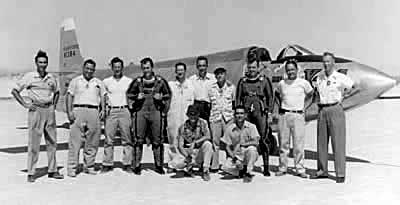 They certainly would not have to “run a structure demonstration” on the airplane.
They certainly would not have to “run a structure demonstration” on the airplane.
A thoroughgoing inspection revealed that no structural damage had been incurred by the X-1A during the violent maneuvers.
No buckling or canning was found on the external surfaces of the aircraft and engineers were surprised to find the flight controls were well within “free” play tolerances. Indeed, apart from the cracked canopy, the only things on the entire airplane that had been damaged were the rate of pitch and yaw indicators.
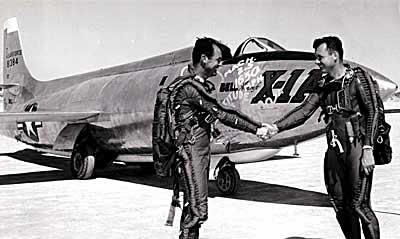 Postflight data analysis revealed that Yeager had achieved a maximum speed of Mach 2.44 (1,650 mph) at 74,700 feet that morning. During his vicious – snapping and rolling and spinning – descent, he plummeted approximately 50,000 feet in 70 seconds and was subject to accelerations of plus 8 g’s, minus 1.3 g and side loads of 2’s.
Postflight data analysis revealed that Yeager had achieved a maximum speed of Mach 2.44 (1,650 mph) at 74,700 feet that morning. During his vicious – snapping and rolling and spinning – descent, he plummeted approximately 50,000 feet in 70 seconds and was subject to accelerations of plus 8 g’s, minus 1.3 g and side loads of 2’s.
A glance at the time histories for yaw, roll, and pitch rates during the first 50 seconds of his tumble provides even more telling evidence.
Some years later, Yeager’s great rival, Crossfield, described this flight as the “fastest and wildest airplane ride in history” and, graciously conceded that “probably no other pilot could have come through that experience alive”. Thus, it was Yeager’s new record which was announced amid much fanfare at the Wright Brothers Memorial Dinner on 17 December and he was subsequently awarded the Harmon Trophy. In regard to all of the accolades, Crossfield concluded: “I didn’t begrudge him one of them. If ever a pilot deserved praise for a job well done, it was Yeager”.
Photo above: Major Charles E. Yeager (far left) congratulating Major Arthur Murray. Both officers established records with the Bell X-1 series research aircraft. The X-1A shown in this photo achieved a speed of Mach 2.5 and an altitude of 90,000 feet plus. Flights were accomplished at the Air Force Flight Test Center.
NOTES:
1. A. Scott Crossfield with Blair Clay, Always Another Dawn: The Story of a Rocket Test Pilot (Cleaveland: World Publishing Co., 1960).
2. Richard P. Hallion, Supersonic Flight: The Story of the Bell X-1 and Douglas D-558 (New York: The Macmillan Conpany, 1972), 171-3; Crossfield, Always Another Dawn.
3. Brig Gen Frank K. Everest, Jr., with John Guenther, The Fastest Man Alive (New York, Toronto, London, Sydney, Auckland; Bantam Books, 1990–reprint of the original 1958 publication).
4. General Chuck Yeager and Leo Janos, Yeager: An Autobiography (Toronto, New York, London, Sydney, Auckland: Bantam Books, 1985).
5. Maj. Charles E. Yeager, Pilot’s Report: X-1A Flight No. 7 (11-21-53), 21 Nov 53; Yeager, Pilot’s Report: X-1A Flight No. 8 (12-2-53), 7 Dec 53; Yeager, Pilot’s Report: X-1A Flight No. 9 (12-8-53), 11 Dec 53.
6. Transcript of Verbal Communications, Bell X-1A Flight No. 10, 12 Dec 53. 7. Maj Charles E. Yeager, Pilot’s Report: X-1A Flight No. 10 (12-12-53), 23 Dec 53.
8. Bell Aircraft Corporation, “X-1A Airplane: Flight Test Progress Report No. 15”, 3 Feb 54.
